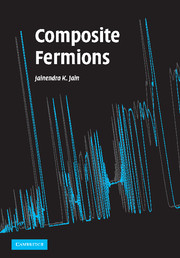Book contents
- Frontmatter
- Contents
- Preface
- List of symbols and abbreviations
- 1 Overview
- 2 Quantum Hall effect
- 3 Landau levels
- 4 Theory of the IQHE
- 5 Foundations of the composite fermion theory
- 6 Microscopic verifications
- 7 Theory of the FQHE
- 8 Incompressible ground states and their excitations
- 9 Topology and quantizations
- 10 Composite fermion Fermi sea
- 11 Composite fermions with spin
- 12 Non-composite fermion approaches
- 13 Bilayer FQHE
- 14 Edge physics
- 15 Composite fermion crystals
- Appendixes
- References
- Index
6 - Microscopic verifications
Published online by Cambridge University Press: 07 December 2009
- Frontmatter
- Contents
- Preface
- List of symbols and abbreviations
- 1 Overview
- 2 Quantum Hall effect
- 3 Landau levels
- 4 Theory of the IQHE
- 5 Foundations of the composite fermion theory
- 6 Microscopic verifications
- 7 Theory of the FQHE
- 8 Incompressible ground states and their excitations
- 9 Topology and quantizations
- 10 Composite fermion Fermi sea
- 11 Composite fermions with spin
- 12 Non-composite fermion approaches
- 13 Bilayer FQHE
- 14 Edge physics
- 15 Composite fermion crystals
- Appendixes
- References
- Index
Summary
Whenever new emergent particles are postulated, one must ask: “So what? What do these particles do for us?” The significance of such particles is determined by the scope and the importance of experimental phenomena they produce. For particles advertised as truly exotic to show up in but minor experimental details would be hardly satisfying.
The remainder of this book concerns experimental manifestations of composite fermions. Before proceeding to laboratory experiments, we ask, in this chapter, if composite fermions can be “seen” in computer experiments.
Computer experiments
Let us recall how quantum mechanics was verified. It began by explaining the spectral lines of the hydrogen atom. With further work, its predictions were seen to be in exquisite agreement with the excitation spectra of helium and other atoms in the periodic table, and also of molecules. This vast body of exceedingly detailed comparisons, now known as quantum chemistry, is what led to the establishment of quantum mechanics as the quantitative theory of matter. Quantum mechanics was then used with great effect in systems containing many electrons, for example metals and superconductors, and now the fractional quantum Hall effect.
This chapter is devoted to the quantum chemistry of composite fermions. Nature does not produce any real “FQHE atoms,” but, fortunately, they can be created on the computer. These atoms are characterized by two parameters: the number of electrons and the amount of magnetic flux to which they are exposed. Theorists can perform computer experiments to determine their exact spectra and wave functions.
- Type
- Chapter
- Information
- Composite Fermions , pp. 174 - 200Publisher: Cambridge University PressPrint publication year: 2007

